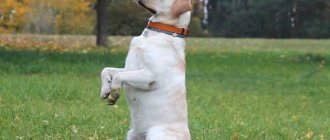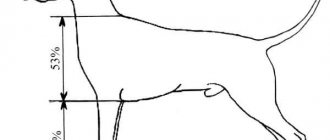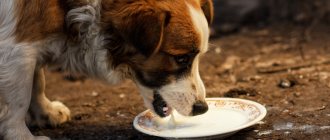Is Labrador Retriever Suitable for Outdoor Living?
The Labrador is a playful and active dog, it belongs to the hunting breeds and can quite easily adapt to environmental conditions. Therefore, breeders answer positively the question whether it is possible to keep a Labrador on the street. The pet will be comfortable both in the apartment and in the yard. However, you can’t just let your dog roam free; you should take care of the following points:
- A spacious and safe enclosure from which the animal cannot escape.
- A warm booth suitable for the size of the dog.
- Toys that your pet can use to entertain himself.
Important! The Labrador is not intended for home protection; it is not a guard dog.
Optimal temperature range
Adaptation of the breed to different types of keeping is a great advantage of these dogs, however, they need to be accustomed to life at home or on the street from childhood. Moreover, it is not recommended to change the place of residence, so as not to cause stress to the animal. Temperatures below 10-15 °C are considered critical for their body. Therefore, Labrador usually remains outside in the summer, spring-autumn, or at any time if the area is warm all year round.
The individual health characteristics of dogs are of great importance: some do not tolerate even -3 °C well, others are comfortable even at -15 °C. In particular, old dogs or those who are often ill, as well as pregnant and lactating females, are moved into the house.
Attention! Can a Labrador live outside in winter - the answer is “yes” if it is relatively warm and mild in the region.
The ideal kennel for a Labrador
So we got to the main building inside the enclosure. How comfortable the Labrador will feel depends on its creation. To do everything right, we recommend that you familiarize yourself with these rules for creating a booth for a Labrador:
- The floor of the structure must be made of hardwood. The material must not show signs of rotting, burrs or roughness. And in order to extend the service life of the tree, it will have to be treated with a protective compound. It is harmless to the animal.
- It is better to create double walls and floor of the booth. This is done in order to insulate the booth. Insulation is placed in this space, which will make the structure warm. In winter, your Labrador will not feel cold in it.
- The insulation can be cheap polystyrene foam, which does an excellent job of thermal insulation, or sawdust. It is recommended to fix the elements using self-tapping screws.
- The roof of the booth can be made flat. Then the dog will use it as his observation post. Ideally, create it so that one of the edges rises and the structure is ventilated.
It is very important to choose the right size booth for your Labrador. This is not done just by eye, but following certain rules. Inside the booth, the Labrador should be comfortable lying, sitting or standing. It is important not to go to extremes: in a very large kennel the pet will be cold inside, and in a small kennel it will be cramped. First, the owner should find out the parameters of his pet in order to create the optimal booth.
To find out the recommended height of the structure, refer to the height of your pet. They usually reach 55 cm, but each pet has its own parameters. Let's take this indicator as a guide. To the height, you should add the height of the bedding (can be hay, shavings or fabric) for the pet and add another 15 cm for comfortable movement around the structure and the ability to sit without touching the ceiling. For example, 55+10+15=80 cm is the optimal height of the booth.
If we talk about the length of the structure, it is equal to the length of the Labrador from the base of its tail to the tip of its nose. As for the vestibule, it is made smaller. After all, the dog will practically not be in it.
The width of the structure is equal to the length of the Labrador from the withers to the tip of the front paws. You need to add another 15 cm to this value so that he can feel comfortable inside.
And finally, let’s look at the height and width of the entrance to the booth. The height should be made less than the height of the Labrador from the withers by 9 cm, and the width, on the contrary, should be 5 cm greater than the width of the pet. In this case, it is better to make the entrance round so that the heat does not leave the booth so quickly.
That's all. Now that all the dimensions are known, you can get to work. As for the design, type of booth, its placement - all this is selected individually. Here they focus on financial capabilities and skills in working with wood. Here is an example of how you can make a dog house with your own hands.
Limitations and features of living on the street
Can a Labrador live outside? Yes, and there are some specifics to street content:
- The animal will be able to show its curiosity and satisfy the need for activity.
- The Labrador will shed naturally without filling the person's home with fur.
- If a pet lives on the street, it will not be able to spoil the household’s belongings.
However, do not forget about the restrictions of living on the street:
- An animal may become bored without the constant presence of its owner.
- To constantly be outside, you need to be in good health - the animal is more susceptible to negative environmental factors.
- Labrador requires the creation of suitable external conditions, at least a kennel.
You need to walk your dog regularly, even if it lives on the street.
Education and training
The Labrador puppy is charming and spontaneous; caring for him should begin from the first day.
Toilet training
Chihuahua: care and maintenance at home
Before the first vaccination, the baby should not be taken outside, and in general it is advisable to limit contact with other animals, even domestic ones. Therefore, it is better for the owner to buy a special diaper for puppies of medium and large breeds and accustom the puppy to it. Possible options:
- trace where exactly the baby prefers to make a puddle and lay a diaper there;
- observe the puppy, as soon as he takes a characteristic pose, quickly put him on the diaper.
Note! You cannot hit the puppy or shout at it, but you should praise and pet it for its success.
Outdoor toilet
Labradors are so smart that they very quickly understand what their owner wants from them. How to get used to walking:
- Choose a collar that is comfortable for the animal, put it on first at home and for a short time, then increase the duration. Such training can be carried out before vaccination to avoid wasting time.
- Always go out at the same hour during the first walk to morally support the puppy, because the street is now a stressful factor for him.
- Wait until the baby goes to the toilet and praise him for his success.
- Give the opportunity to frolic.
Accustoming to cleanliness
This is not an easy task, since representatives of the breed are fully formed by the age of 3, before which they can play around and behave unpredictably. It is important to sternly scold your Labrador for breaking house rules, and not laugh at his antics. The baby should be raised from the first days of life in an apartment or house.
Touching and cute Labrador puppies can captivate even the hardest heart
Accustoming to home environment
Moving to a new home for a Labrador puppy is extremely stressful. It is important to support him and pay special attention. You should not leave your baby alone, especially at night, you should talk to him, stroke him, and try to distract him. Many Labradors try to hide in a corner, and after a while they begin to examine the apartment. At this stage, you should not disturb them; the sooner they explore the place, the more calm they will feel.
Note! Dog handlers recommend getting a dog while on vacation. So the adaptation period will pass under the control of the owner.
What does it take to make your pet comfortable?
Dog breeders recommend purchasing both a home and an enclosure for your Labrador if he lives on the street.
Aviary
A classic enclosure is a wooden or metal structure resembling a fence. It usually has 4 walls, one of which can open. If necessary, a floor is made in the enclosure. Bowls with food and water must be placed inside.
Booth
A booth is a rectangular enclosed space with walls, a floor, a roof and an entrance. It is built to the size of a specific animal, and unlike an enclosure, it has a small area. For its production, environmentally friendly materials such as wood are used (analogue - plywood).
Which is better - a booth or an aviary?
Beginners wonder whether it is possible to keep a Labrador in an enclosure. We can definitely agree with this, since an outdoor corral has a number of advantages:
- Spacious.
- Fresh air.
- The opportunity to play and spend time much more actively than indoors.
- A good addition to periodic walks.
A significant disadvantage of such a fence is that the animal has nowhere to hide from rain and wind, as well as bright sun, unless there is a dwelling with a roof nearby.
The booth has the following advantages:
- This is a comfortable and safe place, a secluded corner that any animal periodically needs.
- You can sleep and relax in it.
- It protects well from bad weather.
There should be enough free space next to the kennel for the dog to move around. In this regard, a private house with a plot of land is convenient.
Important! A dog such as a Labrador is prohibited from being kept on a chain. Tethering is permitted only when necessary.
The pet should have not only an open enclosure, but also a booth
Types of booths
A kennel-shaped booth is suitable for winter. The designs differ in the materials from which they are made. Wood is considered to be of the highest quality, as it is natural, protects against the cold, and is more pleasant for the dog than brick. The tree also protects against drafts and wind if the booth is built correctly.
In the construction of a winter booth, insulation is provided; for this, felt or batting is used. This will retain heat and insulate the dog from the wind.
Convenient kennel booth
Aviary for Labrador
You can buy a pen for your pet or make it yourself.
Purchased aviary
You need to carefully choose the area of the fence: it should be an area of 8 square meters. meters; the width is 1.5 times greater than the animal’s body, and the height is such that the dog can fully stand on its hind legs in the enclosure.
Self-construction
When manufacturing independently, high-quality, strong and reliable materials are used. So, a steel pipe is suitable for the frame. The back walls are made of wood, and the front walls are made of round or square rods. All materials are treated with protective agents against rotting and fungus.
Important! Before construction, be sure to create a design drawing with all calculations.
Aviary care
Labradors are not the cleanest dogs, so systematic cleaning of their habitat is very important: the enclosure is cleared of excrement. You also need to monitor the condition of the walls, floors and fixtures, as they can become unusable due to adverse weather or exposure to dogs. If necessary, they are repaired or replaced with new ones.
Comfortable conditions for living in an enclosure
The pen should be located so as to provide the dog with sufficient visibility of the yard. It is advisable to choose a dry site located slightly on a hill next to the entrance to the house. You should not place objects with a strong smell near the enclosure; it is also not recommended to decorate the fence with flower beds. The animal in the enclosure must have access to food and water.
What should be in the enclosure
The enclosure should have a place for the dog to walk and also a place to sleep and rest. This place should not be huge, but the Labrador should feel comfortable stretching out to its full length.
If you have a female dog, then you need to worry about a maternity area where she and her puppies will feel comfortable and safe.
It is better to make the opening between the sleeping place and the observation deck in a semicircle. This way less heat will be lost.
Do not forget that the dog must relieve itself somewhere, as well as play and simply stretch its bones. Therefore, it is worth taking care of a spacious place in the booth.
Don't forget that the booth needs bowls for water and food. They should not stand near the lattice part, as various unpleasant substances can get there.
It is advisable to secure the bowls at a height of 20-30 cm from the floor. This way you will protect the dog from being fed by strangers.
Place toys and bones for your pet in the enclosure, then he won’t be bored when you’re busy, at work, or just away for a few hours.
You can look on the Internet or from your neighbors to see what kind of enclosures they make for their pets.
This way you can stumble upon real masterpieces that you can try to translate into reality and create all the conditions for a comfortable life for a Labrador.
After all, by spending a small amount of time you will create a real piece of paradise for your four-legged friend.
Kennel for Labrador
Booths have their own requirements.
Types of booths
Booths are divided according to different criteria:
- Material - wood, plastic, concrete or metal.
- Dimensions. The house must correspond to the size of the pet, and may have additional extensions, for example, a vestibule or an open area near the entrance.
- The roof structure is flat, two-pitch or single-pitch.
- Availability of insulation. Insulated options are equipped with a double floor, while the bottom is raised above the ground.
You can make a dog house yourself
Optimal sizes
Inside the kennel, the dog should be able to stand upright and lie down freely. Its height and depth are made equal to the height of the dog, with a margin of 10-15 cm.
Attention! A narrow booth provokes diseases of bones and joints; too large one will cool down and prevent the pet from warming up in winter.
How to insulate a booth
Materials for the kennel should be natural, most often it is hardwood. If you are planning a winter version of your home, the walls need to be made double. Between them is laid insulation in the form of sawdust, foam, which can retain heat in cold weather.
Optimal sizes
Before buying a kennel, you need to make sure that the dog can enter it without discomfort, fit freely so that the paws or any other part of the body do not stick out from the opening. To do this, measure the dog's height and add at least 20 cm to it. These are the dimensions for the width and height of the future booth.
Important! The depth is determined by the Labrador's body length plus a minimum of 15 cm.
These are the minimum values, but it is best to add another 5 cm for the pet’s comfort. The main thing is not to reduce the area.
The height of the enclosure should be such that the Labrador, standing on its hind legs at full height, does not rest its head on the roof. That is, the same as with the booth, add +20 cm to the length of the pet. The area depends on how many square meters the owner can afford. The larger the better, but not less than 8 m².
Spacious enclosure
Why walking is important
Labradors are inquisitive, playful and active dogs. They really appreciate long walks and physical activity. They also need this for physiological reasons: representatives of this breed are prone to obesity. For companion dogs, human interaction is extremely important. Therefore, a long walk is another reason to spend time with your four-legged friend. They walk an adult 2-3 times a day, and more often with a puppy. Walks are combined with training and teaching basic commands. If possible, you should take your pet to a lake or river, as Labradors love to swim.
Features of maintenance and care
In order for an animal to have good health and mood, it needs to be provided with:
- Balanced diet. This can be a diet made from natural products, special dry food, as well as various vitamin bones and sticks.
- Timely walks.
- Periodic bathing as soiled. It is permissible to use only dog shampoo.
- Coat care – combing and brushing several times a week, preferably with a special brush. Labradors are not usually trimmed.
- Ear care – inspection for parasites and cleaning.
- Trimming nails, provided that they are not sharpened and interfere with the dog’s movement.
- The pet must undergo a course of vaccinations.
Labradors require special care
. Important! Labradors often have allergies, develop mastitis, and are at risk of strokes and collapse. Therefore, all large dogs are observed by a doctor.
From the above, we can already draw conclusions about whether it is possible to keep a Labrador outdoors. Both living at home and living in the yard have their pros and cons. In both cases, the dog needs to create suitable conditions for a comfortable life.











